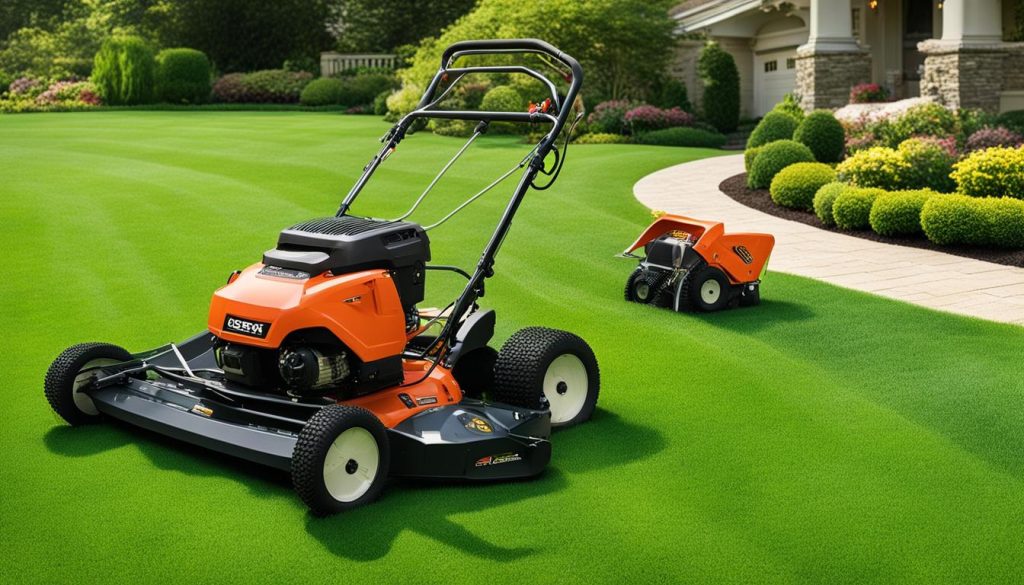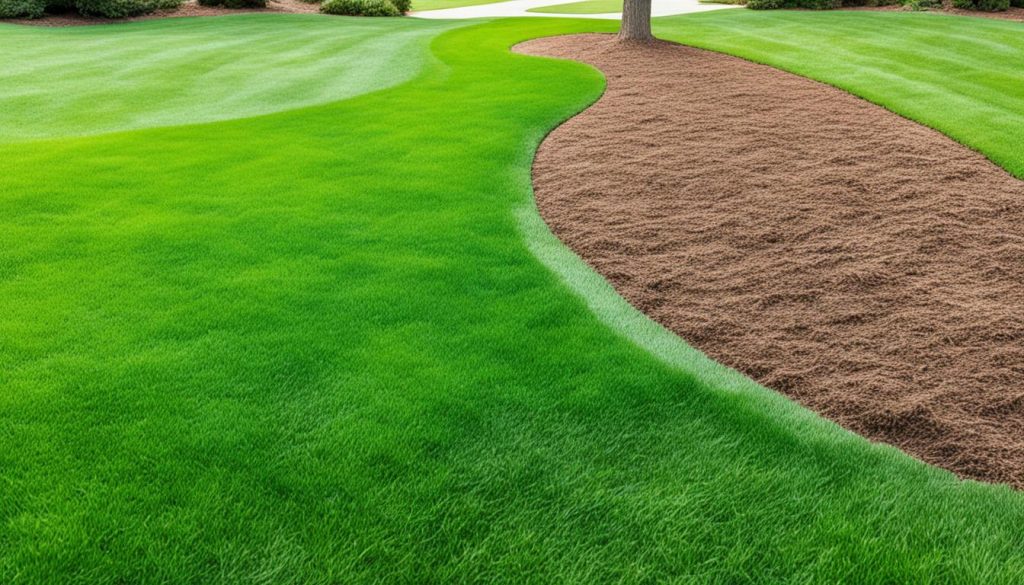Did you know that a well-maintained lawn can increase the value of your property by up to 15%? That’s right, a lush, green lawn not only enhances the aesthetic appeal of your outdoor space but also adds significant value to your home. If you’ve been dreaming of a beautiful lawn that will make your neighbors green with envy, it’s time to learn how to renovate your lawn and give it the makeover it deserves!
Renovating a lawn may seem like a daunting task, but with the right techniques and tools, you can transform your tired, patchy lawn into a vibrant and healthy landscape. Whether you have a small backyard or a sprawling garden, this article will guide you through the step-by-step process of lawn renovation, providing you with valuable tips and ideas along the way.
Key Takeaways:
- Renovating your lawn can significantly increase the value of your property.
- With the right techniques and tools, you can transform a tired lawn into a vibrant landscape.
- This article will guide you through the step-by-step process of lawn renovation.
- Learn valuable tips and ideas to achieve a lush, green lawn.
- A well-maintained lawn enhances the aesthetic appeal of your outdoor space and adds value to your home.
Is Autumn a Good Time to Renovate Your Lawn?
When it comes to lawn care, autumn is an ideal season for renovation. The weather conditions during this time provide the perfect opportunity to revitalize your lawn and ensure it stays healthy and vibrant throughout the year.
One of the main advantages of renovating your lawn in autumn is that the ground is still warm from the summer heat. This warmth helps in the germination of seeds, allowing them to establish strong root systems before the arrival of winter. Additionally, autumn usually brings plenty of moisture in the form of rain, which further aids in the growth of new grass.
Scarifying and overseeding a mossy lawn in the autumn can work wonders for its overall health and appearance. Scarifying helps to remove thatch and moss, while overseeding fills in any bare patches and thickens the turf. The combination of these two techniques can transform a lackluster lawn into a lush and vibrant green space.
Furthermore, the watering needs of your lawn are generally lower in autumn compared to the dry springs of recent years. The moisture from rain is less likely to evaporate quickly, reducing the need for constant watering. However, it is important to monitor the moisture levels and adjust watering as necessary to ensure proper growth and establishment of the newly seeded areas.
Although autumn can be a bit muddy during lawn renovation, the benefits far outweigh the temporary inconvenience. By taking advantage of the warm ground, ample moisture, and lower watering needs, you can ensure that your lawn is in top condition for the following seasons.
In the next section, I will discuss the essential equipment needed for a successful lawn renovation.
Equipment Needed for Lawn Renovation
When it comes to renovating your lawn, you don’t need a multitude of specialized equipment. For smaller lawns, basic tools like a mower, spring tine rake, and garden fork will suffice. However, for larger lawns or more extensive renovations, it is recommended to invest in electric or petrol machines for better results.
The key equipment for lawn renovation includes:
- A mower: to cut the existing grass down to the desired height before the renovation process begins.
- A scarifier: which can be hired if you don’t already own one. The scarifier is used to remove any dead grass, moss, or thatch from the lawn’s surface, allowing the new seed to take root more effectively.
- An aerator: also available for hire, helps to improve soil compaction by creating small holes in the ground. This allows for better air circulation and water absorption, promoting stronger root growth.
- A seed/fertilizer spreader: to evenly distribute the new seed and nourishing fertilizer across the lawn. This ensures consistent coverage and encourages healthy germination.
- A rake: a versatile tool used throughout the renovation process, including removing debris, leveling soil, and breaking up clumps of soil or thatch.
- A stiff brush/level lute: for evenly spreading top dressing materials such as compost or topsoil after scarification and seeding.
- A garden roller: potentially necessary for larger lawns or areas that require leveling after renovation. The roller helps to press the soil and seed into place, ensuring good seed-to-soil contact for optimal germination.
Having the right equipment will make the lawn renovation process more efficient and increase the chances of achieving a lush and healthy lawn. Consider the size of your lawn and the extent of the renovation needed to determine which equipment is necessary for your project.

Step-by-Step Guide to Lawn Renovation
If you’re looking to renovate your lawn and give it a fresh new look, follow these simple steps:
- Mow the lawn low: Start by cutting the grass as low as possible. This will help remove any excess thatch and make it easier for the new seed to reach the soil.
- Scarify the lawn: Use a rake or a scarifier to remove any dead grass, moss, and thatch from the surface of the lawn. This process will help aerate the soil and create space for the new grass seed to grow.
- Spread the seed: Once the lawn has been scarified, spread a generous amount of grass seed evenly across the entire area. Make sure to choose a seed that is suitable for your climate and lawn conditions.
- Top dress the lawn: After spreading the seed, apply a thin layer of top dressing over the lawn. This can be a mixture of compost, sand, and soil. The top dressing will help improve the soil quality and provide nutrients for the new grass to thrive.
Once you’ve completed these steps, it’s important to water the lawn regularly and keep it well-maintained. In a few weeks, you’ll start to see new grass sprouting and your lawn will be on its way to a lush and revitalized appearance.
Remember to be patient, as it may take some time for the new grass to establish and fill in the bare patches. Continue to provide proper care and maintenance to ensure the long-term health and beauty of your lawn.

How to Revive a Dead Lawn
If your lawn is completely dead, don’t despair! With proper preparation and a few steps, you can bring it back to life. Here’s what you need to do:
- Properly prepare the site: Start by removing any debris, rocks, or weeds from the area. Clearing the site will create a clean canvas for the new grass to grow.
- Remove excess thatch: Thatch is a layer of dead grass and debris that accumulates on the surface of the soil. Use a rake or a special thatch removal tool to thin out the layer and allow water and nutrients to reach the roots.
- Test the soil: It’s important to know the pH level and nutrient content of the soil. You can do this by using a soil testing kit or sending a sample to a local agricultural extension office. Based on the results, you can adjust the soil’s pH or add necessary nutrients.
- Choose the right grass seed: Select a grass seed that is suitable for your climate, soil type, and light conditions. Consider factors like shade tolerance, drought resistance, and traffic tolerance to ensure a successful lawn revival.
- Seed the lawn: Spread the grass seed evenly over the prepared site. Use a seed spreader for larger areas or broadcast by hand for smaller patches. It’s recommended to overseed to ensure uniform coverage.
- Water properly: After seeding, water the area consistently to keep the soil moist. Avoid overwatering, as it can lead to fungal diseases. Follow watering instructions specific to the grass seed you’ve chosen.
- Maintain the lawn: Once the grass starts growing, gradually adjust your mowing height to the recommended level. Regularly fertilize and aerate the lawn to promote healthy growth.
Reviving a dead lawn requires patience and proper care, but with these steps, you’ll be well on your way to a lush, green yard once again.
Aftercare for a Revived Lawn
After reviving your lawn, proper aftercare is crucial for its long-term health. Here are some guidelines:
- Deep irrigation: After seeding your lawn or applying new sod, it’s important to provide deep irrigation to encourage strong root growth. Deep watering helps the roots penetrate deeper into the soil, making the lawn more resilient to drought and stress. Water the lawn thoroughly, ensuring the water reaches a depth of at least 6 inches.
- Proper mowing height: Set your mower blades to the recommended height for your grass type. Mowing too low can stress the lawn and inhibit root growth, while mowing too high can encourage disease and weed growth. Maintain a proper mowing height to promote a healthy and well-maintained appearance.
- Fertilization: After the initial growth, it’s essential to provide the necessary nutrients to support the lawn’s health and vigor. Apply a balanced fertilizer according to the manufacturer’s instructions, taking care not to over-fertilize as it can lead to excessive growth and nutrient runoff.
- Weed control: As your revived lawn starts to flourish, it’s important to keep it weed-free. Regularly inspect the lawn for weeds and apply appropriate weed control methods, such as hand pulling or spot treatment with a selective herbicide, to prevent weed competition for nutrients and sunlight.
- Aeration: Periodically aerate your lawn to alleviate soil compaction and promote proper airflow, nutrient absorption, and root development. Aeration helps water and nutrients penetrate the soil effectively, resulting in a healthier and more resilient lawn.
- Regular maintenance: Maintain a consistent lawn care routine, including regular mowing, watering, and removal of leaves and debris. This will help keep your revived lawn in optimal condition and prevent the reemergence of any issues.
Common Causes of Yellow or Dead Grass
When your grass starts to turn yellow or die, there are usually several common causes to consider. One of the common culprits is poor lawn preparation and installation. A healthy lawn requires proper soil preparation, including removing debris, tilling the soil, and adding necessary amendments. Failure to do so can result in nutrient deficiencies and poor grass growth.
Improper cultural practices can also contribute to yellow or dead grass. This includes watering, feeding, and mowing. Overwatering or underwatering can stress the grass and lead to its decline. Similarly, applying too much or too little fertilizer can also harm the grass. It’s important to follow recommended guidelines for watering and fertilizing your lawn.
Using the wrong grass type for your climate and light conditions is another common cause of yellow grass. Different types of grass have specific requirements in terms of sunlight, temperature, and moisture levels. Choosing a grass variety that is not well-suited to your local conditions can result in poor growth and yellowing.
Last but not least, pests and diseases can wreak havoc on your lawn, causing yellow or dead patches. Insects like grubs, chinch bugs, and armyworms can damage grass roots and suck out its nutrients. Fungal diseases can also attack the grass, leading to discoloration and deterioration.
To prevent further damage or revive yellow or dead grass, it’s important to address these common causes. Proper lawn preparation, including thorough soil preparation and choosing the right grass type, is essential. Additionally, adopting proper cultural practices, such as watering deeply and infrequently, feeding your lawn with the correct amount of fertilizer, and mowing at the appropriate height, can help rejuvenate your grass. If pests or diseases are present, it may be necessary to take targeted measures to control and eliminate them.

Leave a Reply
You must be logged in to post a comment.